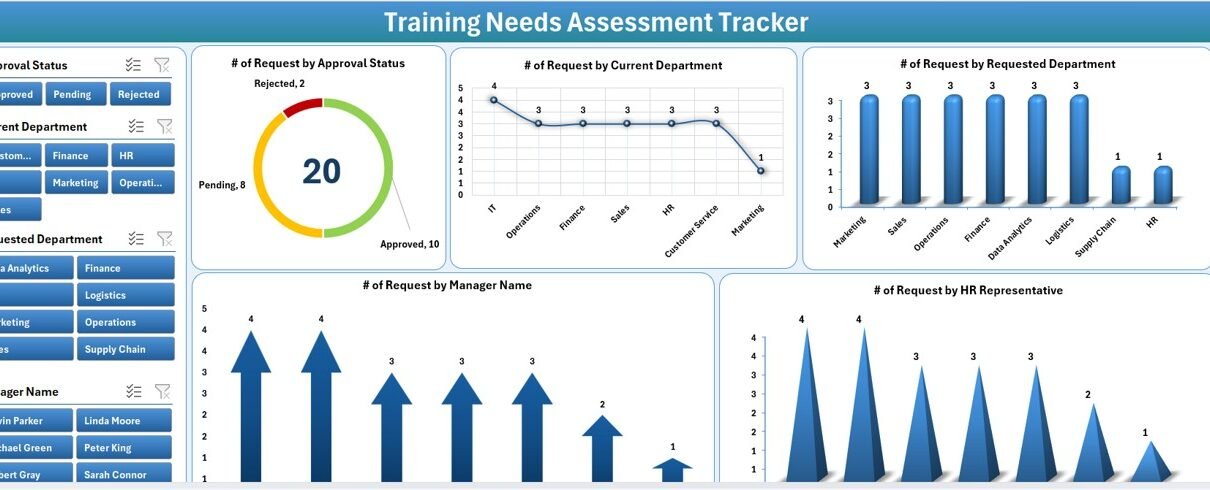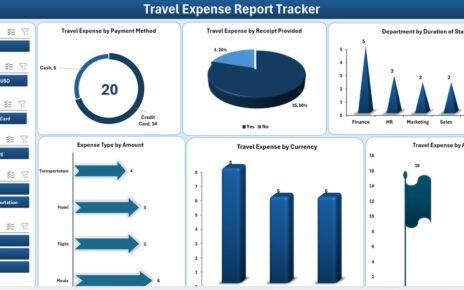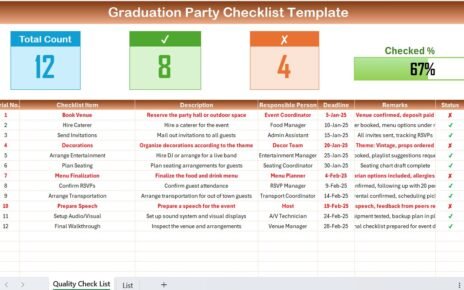Managing employee transfers within an organization can be challenging without a proper system. HR departments often struggle to keep track of requests, approvals, and departmental movements. To simplify this process, we’ve designed the Internal Transfer Request Tracker in Excel, a ready-to-use and VBA-powered tool that centralizes every detail — from transfer requests to approvals and updates — all in one user-friendly dashboard.
This article will walk you through the features, benefits, and best practices of using this tracker, and how it helps HR teams manage internal movements with efficiency and accuracy.
Click to Purchases Internal Transfer Request Tracker in Excel
What Is an Internal Transfer Request Tracker in Excel?
An Internal Transfer Request Tracker is an Excel-based application built with VBA (Visual Basic for Applications) that helps HR departments manage employee transfer requests digitally. Instead of relying on emails or paper forms, this tracker automates data collection, status updates, and reporting.
Employees can submit transfer requests, managers can review and approve them, and HR can monitor the complete process — all from one secure Excel file.
This tool acts as both a workflow manager and reporting dashboard, reducing administrative workload and improving transparency in employee movement tracking.
Key Features of the Internal Transfer Request Tracker in Excel
The Internal Transfer Request Tracker comes with several powerful features that make it easy to use and manage. Let’s explore each one in detail.
1️⃣ Login Form – Secure Access
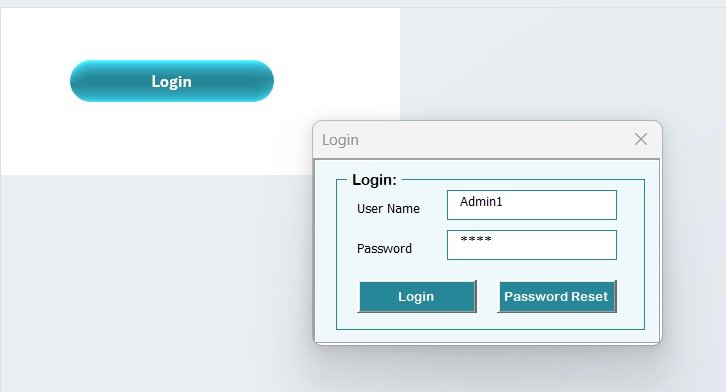
The tool starts with a Login Form, designed for secure and personalized access.
-
Users enter their User ID and Password (e.g., Admin1 / abcd).
-
After logging in, they are directed to the Main Form.
-
This ensures that only authorized personnel can view or modify transfer data.
2️⃣ Main Form – Central Control Panel
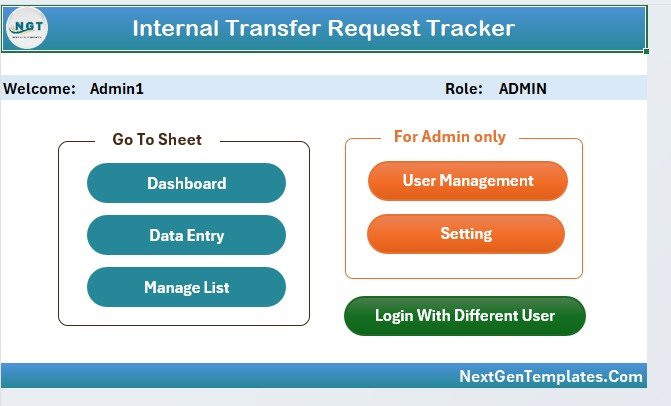
The Main Form acts as the hub of the entire system. Once logged in, users can perform all critical actions from here.
You can:
-
Add New Requests
-
Update or Delete Existing Records
-
View Dashboard Reports
-
Access User Management and Settings
This main form simplifies the workflow by providing buttons, filters, and shortcuts — so users don’t have to navigate multiple sheets manually.
3️⃣ Dashboard Sheet Tab – Visual Analytics
Click to Purchases Internal Transfer Request Tracker in Excel
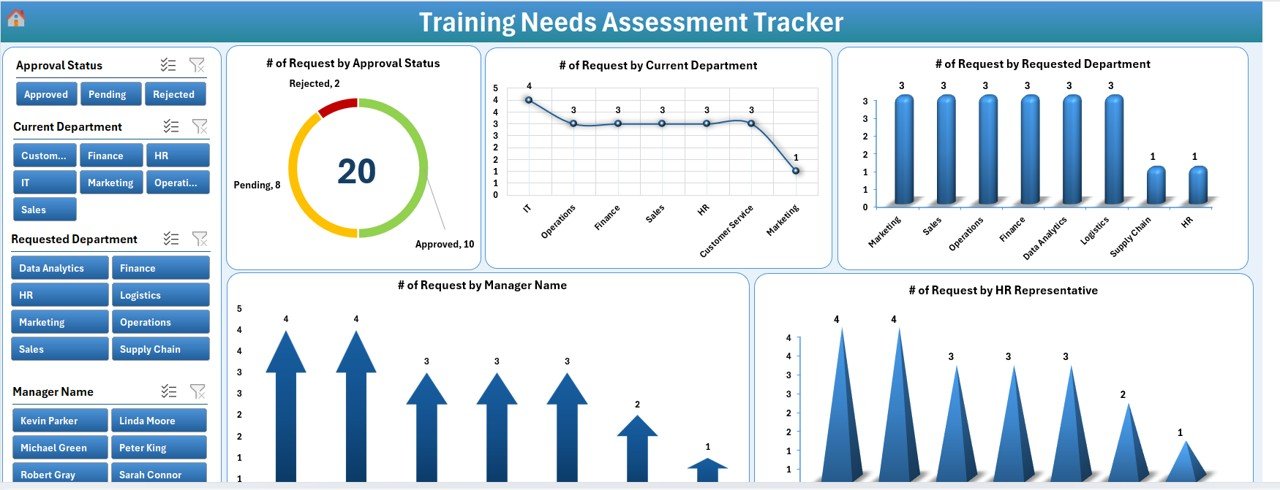
The Dashboard sheet presents key insights through dynamic charts and slicers.
It helps HR teams visualize performance, identify bottlenecks, and monitor request trends.
📊 Dashboard Highlights:
-
# of Requests by Approval Status – See how many transfers are approved, pending, or rejected.
-
# of Requests by Current Department – Analyze which departments are initiating transfers.
-
# of Requests by Requested Department – Identify where most employees are moving.
-
# of Requests by Manager Name – Track approvals by managerial level.
-
# of Requests by HR Representative – Evaluate HR workload and response times.
4️⃣ Data Entry Sheet Tab – Simplified Data Management

The Data Entry sheet serves as the operational heart of the tracker.
It contains all employee transfer records and buttons for data management.
At the top of this sheet, you’ll find three key buttons:
➕ Add New Record
Clicking this button opens a Data Entry Form.
-
Fill in employee details, current department, requested department, manager name, and HR representative.
-
Submit the form to automatically insert the record into the database.
-
The dashboard updates instantly with the new data.
✏️ Update Record
If you need to modify any record:
-
Select the record ID.
-
Click the Update Record button.
-
The form will open with prefilled data for easy editing.
-
Once updated, the dashboard will refresh automatically.
❌ Delete Record
To remove a record:
-
Select the record ID.
-
Click Delete Record.
-
The tool will confirm before deletion, preventing accidental removals.
5️⃣ Manage List Sheet Tab – Custom Dropdown Management
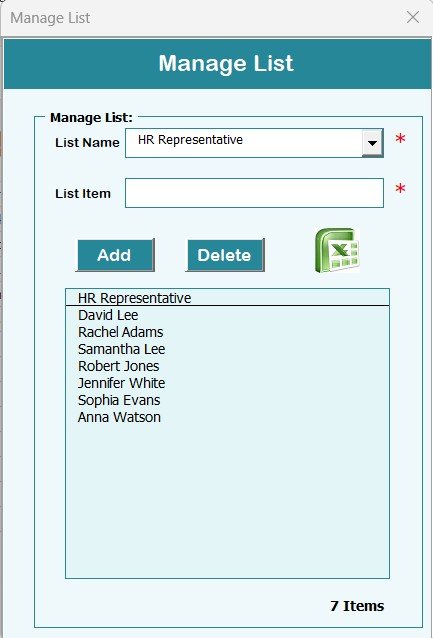
The Manage List Sheet contains the dropdown lists used in the data entry form.
For example, lists for departments, managers, HR representatives, and approval statuses.
You can:
-
Add New Items to dropdown lists
-
Delete Unused Items
-
Automatically sync the updates with all form fields
This ensures that data entry remains consistent and eliminates spelling errors or mismatched department names.
6️⃣ Support Sheet Tab – Backend Data Engine
The Support Sheet is a hidden sheet that powers the analytics.
It stores pivot tables that drive the dashboard’s charts.
Users don’t need to modify this sheet — it runs automatically behind the scenes.
By hiding this sheet, the tool maintains a clean interface and prevents accidental changes to backend calculations.
7️⃣ User Management Module – Multi-User Environment
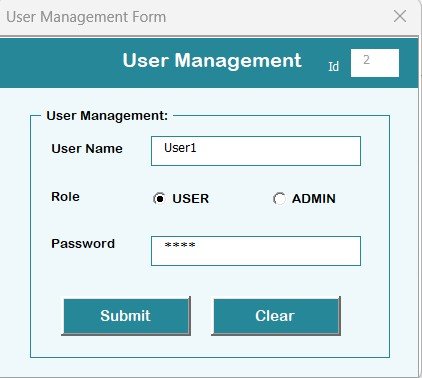
The User Management feature is ideal for organizations with multiple HR executives or department heads managing transfers.
With this module, you can:
-
Add new users (HR, Manager, Admin)
-
Update user details or reset passwords
-
Delete inactive users
-
Assign role-based permissions
This functionality ensures accountability while maintaining data security and role segregation.
8️⃣ Settings Sheet – Full Customization
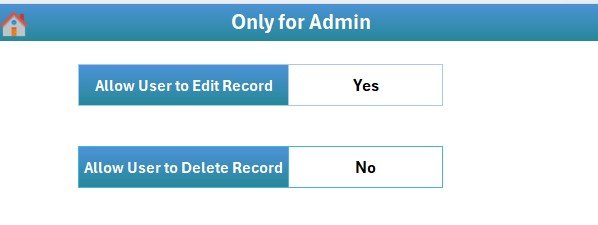
The Settings Sheet allows you to personalize the tracker according to company requirements.
You can:
-
Adjust form labels
-
Define default approval workflows
-
Update company name and color themes
-
Enable or disable certain features
This customization ensures that the tracker adapts to your organization’s HR policy.
9️⃣ Login with Different Users
Different users can log in using unique credentials to manage or view specific sections.
For example:
-
HR Admins can access all requests and manage user settings.
-
Managers can only view or approve requests related to their departments.
This multi-level access keeps the workflow structured and secure.
How the Internal Transfer Request Tracker Works
Click to Purchases Internal Transfer Request Tracker in Excel
The tracker follows a simple yet structured process:
-
Login: The user logs into the system using a valid ID and password.
-
Add or Update Requests: Users can add or modify internal transfer requests through forms.
-
Automatic Data Update: Once submitted, the dashboard and data sheets refresh automatically.
-
Dashboard Review: HR and management can visualize trends, approval rates, and pending requests.
-
User Management & Settings: Admins can modify user access, adjust system settings, or manage dropdown lists.
Every action triggers automated VBA macros, reducing manual work and maintaining data integrity.
Why Use an Internal Transfer Request Tracker?
Manual management of transfer requests often leads to errors, missed approvals, and lack of transparency.
Using a digital tracker ensures consistency, visibility, and efficiency across all departments.
Here’s why it’s a game changer:
-
Eliminates paperwork and email confusion.
-
Provides real-time updates to management.
-
Ensures data accuracy through controlled inputs.
-
Improves decision-making with insightful reports.
-
Enables quick access to employee transfer history.
Advantages of Internal Transfer Request Tracker in Excel
Using this Excel-based tracker provides numerous benefits across HR and management operations.
✅ 1. Centralized Data Management
All requests, approvals, and comments are stored in one Excel file.
It acts as a single source of truth for the HR department.
✅ 2. Time Efficiency
Automated forms, buttons, and macros reduce repetitive work.
HR teams can process more requests in less time.
✅ 3. Better Decision-Making
Interactive dashboards and charts highlight key metrics, such as transfer rates by department or manager.
✅ 4. Improved Accountability
Role-based login ensures that only authorized users can edit or approve records, enhancing data security.
✅ 5. Error-Free Processing
Predefined dropdowns and lists minimize human errors and maintain consistency.
✅ 6. Cost-Effective Solution
Unlike expensive HR software, this Excel tool provides similar automation and insights at a fraction of the cost.
Best Practices for Using the Internal Transfer Request Tracker
To make the most out of your Internal Transfer Request Tracker, follow these best practices:
💼 1. Maintain a Regular Backup
Always create a backup copy of the Excel file before major updates or version changes.
💼 2. Use Role-Based Access
Assign login credentials based on user roles (HR, Manager, Admin) to ensure data integrity.
💼 3. Keep Dropdown Lists Updated
Regularly review and update the Manage List Sheet to reflect new departments, roles, or HR representatives.
💼 4. Refresh the Dashboard
If new data doesn’t appear immediately, refresh the pivot tables or use the refresh button to update charts.
💼 5. Protect Backend Sheets
Hide or password-protect the Support Sheet and Settings Sheet to avoid accidental modifications.
💼 6. Review Data Monthly
Analyze dashboard charts monthly to identify departmental transfer trends and workload patterns.
💼 7. Train Users Before Implementation
Provide short training or user guide documentation to HR and department heads before rolling out the tool.
🔍 How to Customize the Internal Transfer Request Tracker
The flexibility of Excel makes customization easy.
You can modify forms, charts, and lists according to organizational needs.
Possible Customizations:
-
Add a company logo or color scheme
-
Include new slicers like “Transfer Reason” or “Priority”
-
Add conditional formatting to highlight urgent requests
-
Modify approval workflows based on hierarchy
-
Integrate with Outlook via VBA for email notifications
With VBA integration, you can even automate email alerts when a transfer request is approved or rejected — making it behave like professional HR software.
Real-World Use Case Example
Scenario:
A mid-sized organization with 500 employees faced delays in internal transfers due to email-based approvals.
By implementing the Internal Transfer Request Tracker, they achieved the following within 3 months:
-
Reduced approval turnaround time by 45%
-
Improved HR team efficiency by 30%
-
Achieved 100% accuracy in data tracking
-
Provided department-wise trend analysis to management
This real-world success highlights how Excel automation can replace bulky HR systems effectively.
Conclusion
The Internal Transfer Request Tracker in Excel is more than just a spreadsheet — it’s a complete HR workflow management solution.
With built-in automation, dashboards, and secure access, it streamlines the internal transfer process while maintaining full control and transparency.
Whether you’re a small business or a large enterprise, this tool helps standardize employee movements, reduce manual errors, and enhance productivity — all without needing expensive HR software.
If you want an affordable, efficient, and ready-to-use system for managing employee transfers, this Excel tracker is the perfect solution.
❓ Frequently Asked Questions (FAQs)
Q1: Can this tracker be used by multiple users at once?
Answer: Yes, but it’s recommended to use shared access carefully. For best performance, keep one active user at a time or deploy it on a shared network drive with version control.
Q2: Do I need to enable macros to use the tracker?
Answer: Yes, this tool is built using VBA macros. You need to enable macros when opening the file to ensure all forms, buttons, and dashboards work properly.
Q3: Can I customize the login credentials?
Answer: Absolutely. You can edit or add new users in the User Management section, including changing passwords and permissions.
Q4: How often should I update the Manage List Sheet?
Answer: Review it monthly or whenever new departments, managers, or HR representatives are added.
Q5: What Excel version is required for this tool?
Answer: The tracker works best with Microsoft Excel 2016 or later (Windows version). VBA functionality may vary in online or Mac versions.
Q6: Can I add email notifications for approvals?
Answer: Yes, with slight VBA customization, you can integrate Outlook to send automatic emails upon request approval or rejection.
Q7: Is training required before using the tracker?
Answer: Minimal. The tool is intuitive and comes with clear labels and buttons. However, a short walkthrough helps first-time users.
Q8: Can I hide certain sheets for security?
Answer: Yes. You can hide or password-protect backend sheets like Support or Settings to prevent accidental edits.
Visit our YouTube channel to learn step-by-step video tutorials
Click to Purchases Internal Transfer Request Tracker in Excel
